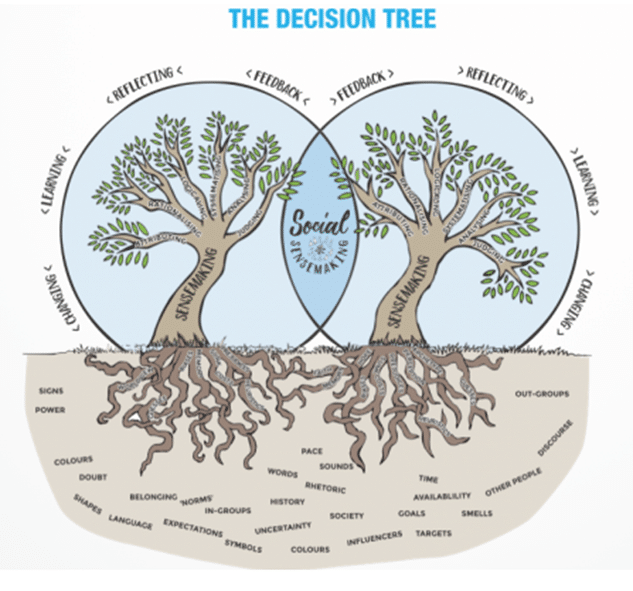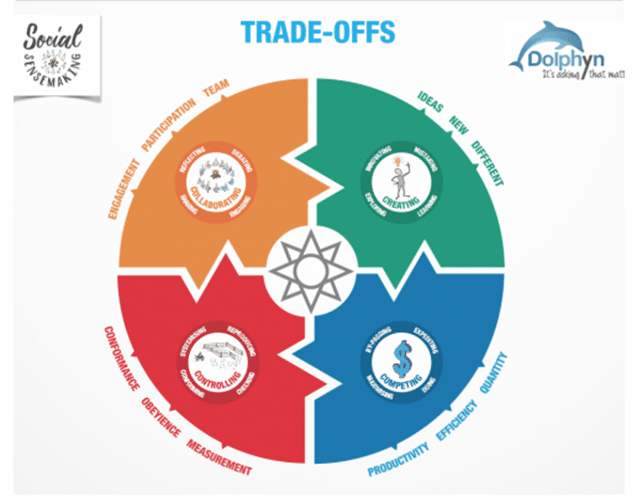Originally posted on July 9, 2018 @ 8:48 AM
Models From Social Sensemaking
In this piece I introduce you to two of the semiotic models developed in my first book Social Sensemaking. Firstly, The Decision Tree and then The Trade-offs Model.
The Decision Tree
Why is it challenging to accept that many of our ideas and thoughts originate in our unconscious? What is it that seduces us into believing that all of our decisions are clear ‘choices’; made rationally and logically? Finally, what do our social arrangements, our organising and our being in the world with others, have to do with the decisions we make?
These questions are explored in the Decision Tree which in the book I describe as:
“…The model is meant to firstly symbolically differentiate between the factors relating to our decisions and judgments that occur in our non-conscious (non-exposed or symbolically ‘under the ground’) and then to highlight the things that we do as we make decisions (the branches) and then afterwards as we reflect and learn (open to view or ‘above the ground’ as in the exposed structure of the tree). The roots of the tree include the factors that relate to us as individuals and they are surrounded by the earth (soil) which is meant to symbolise the more social factors that impact on our decisions. They are depicted in the ‘messiness’ of the soil as a way to demonstrate that, not only are they often hidden from us (under the ground), but may be challenging to understanding being in the mix of the soil (dirt, rocks, humus, worms and subterranean bugs etc.) and the entanglement of the roots.”
The Decision Tree was developed to provide a semiotic representation of ‘sensemaking’. It aims to represent what is a complex and multifaceted activity, into a format that may be easier to grasp; that is, via a model. However, as my friend Craig Ashhurst is known to suggest; “all models are wrong, but useful”. That is, a model is not intended as a ‘complete’, nor perfectly scientific explanation of how we make sense of things, rather it is a tool to prompt further thinking and hopefully discussion on the topic.
So how did we come to the representation of sensemaking?
To start, it was another model known as One Brain Three Minds, developed by Dr. Robert Long, that first caught our attention. This model introduces us to a way of appreciating the complexities of decision making, by helping us to recognise the importance, and the influence of, our unconscious (Mind 2 and 3). It also helps us to appreciate that our individual decision making is so much more than a simple ‘choice we make’.
One Brain Three Minds from Human Dymensions on Vimeo.
Instead, there are many and varying factors that influence our decisions, including those associated with the way in which we organise ourselves, along with many societal or social factors. This is why in the Decision Tree model, we further explore these social influences and the many other varying and complex stimuluses that impact on decision making. If you’d like to learn more about the Decision Tree, you can watch this short video that I recently prepared.
Social Sensemaking – The Decision Tree from Social Sensemaking on Vimeo.
Let’s now turn our attention to the next model, The Trade-offs Model.
The Trade-offs Model
Have you ever heard yourself suggesting emphatically that something, say for example; your health, your relationship with your child or your job, is your first priority? Why do we think like this? What is it that seduces us into such simplistic thinking? Can anything ever be our first priority, all of the time? Why might we struggle to accept that rather than having one key priority or focus, that instead we are constantly ‘trading-off’ in our decision making?
I explore these questions below as I introduce you to The Trade-Offs Model.
This model based on the work of Cameron and Quinn (2011) who, in their book Diagnosing and Changing Organisational Culture introduce us to the Competing Values Framework. It includes four quadrants, each depicting the different focuses (or values) that organisations may have. However, remember this is a model, and as such summarising complex ideas into a more simple framework comes with it’s own trade-offs and as noted above, may be ‘wrong, but useful’!
The four quadrants are; Collaborating, Creating, Controlling and Competing. The key argument put forward in the model is that while we may easily be misled into thinking that we can focus equally on all four of these areas all of the time, in reality, we are forced in many ways to choose between them. That is, in order to focus on one thing more than another, we are required to trade-off something else.
Sensemaking and ‘choices’ may also bring with them a sense of tension and unease, as we go about ‘trading-off’. We can’t be sure in knowing what is the ‘right’ or ‘correct’ choice or decision. As a way of coping with this, we ‘satisfice‘ and may develop hubris or over confidence. This may mean that we become blind to the tension of trade-offs and perhaps even deceived into thinking that our decisions are not without consequence or significance.
Maybe this is a necessary way to handle the tension in decision making, for if we were to become too consumed by this, conceivably, we would not be able to cope? Equally though, if we do not accept and be present to our often contradictory ways of sensemaking and the tension of the trade-offs, conceivably we would not learn and this would impact on how we understand and discern risk?
You can learn more about the Trade-offs model in this short video.
Trade-Offs Model from Social Sensemaking on Vimeo.
It is almost two years since Social Sensemaking was published. The learning, pondering and reflecting continue, as does my understanding of sensemaking.
Maybe that is because sensemaking is an ongoing activity rather than something that is done or completed. Maybe also it ought be understood dialectically, with the necessary tension and also uncertainty. Maybe we are moved too easily to believe that we ‘know’ something, rather than accept the role of faith in sensemaking? There seem many questions.
How do you make sense of risk?





Do you have any thoughts? Please share them below